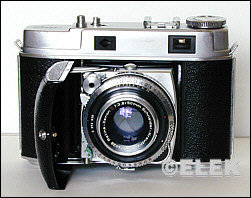Retina IIc

|
|
|
| Style, film format | Folding 35mm with coupled rangefinder and interchangeable front elements |
|
|
|
| Lens, shutter | Coated 50mm f/2.8 Schneider-Kreuznach Retina-Xenon, Synchro-Compur |
|
|
|
| Photo quality | Very good to excellent |
|
|
|
| Ergonomics | Very good, but quirky when using wide angle or telephoto (see text) |
|
|
|
Kodak AG's introduction of the "b" and "c" series cameras brought with it a larger and more rounded body. The new Retinas were still folding cameras and for the most part still featured a sharp, coated Schneider-Kreuznach Xenon lens in a Synchro-Compur shutter. (A highly regarded Rodenstock Heligon also was available.)
You can see how the lens door is rounded, as well as the ends of the camera. The camera was slightly wider, giving the photographer a little extra space for the right hand.
Visually, the new Retinas were beautiful cameras -- a nice mix of form and function.
The "c" Retinas also introduced interchangeable front elements. In addition to the standard 50mm, there also was a 35mm wide angle or an 85mm portrait lens. However, it wasn't as easy as that. Best results were accomplished when using the auxiliary viewfinder. And focusing took extra time and patience. You first focused on your subject through the viewfinder. You then read the distance setting and refocused the lens slightly, using one of two scales on the underside of the lens. Then you would frame your shot using the auxiliary viewfinder and take your photo. Of course, landscapes were a snap. Portraits -- another story. For sports -- no way.
Still, the Retina IIc is an extremely friendly camera although heavier than the earlier Retinas. You can figure out most of the controls within a few minutes. Like other Retinas, it uses a countdown frame counter that locks the film advance after the last shot.
Once properly serviced, the rangefinder patch is reasonably clear, though the later Big C models improved markedly in this area.
Still, as classic cameras go, it's a fine choice.
